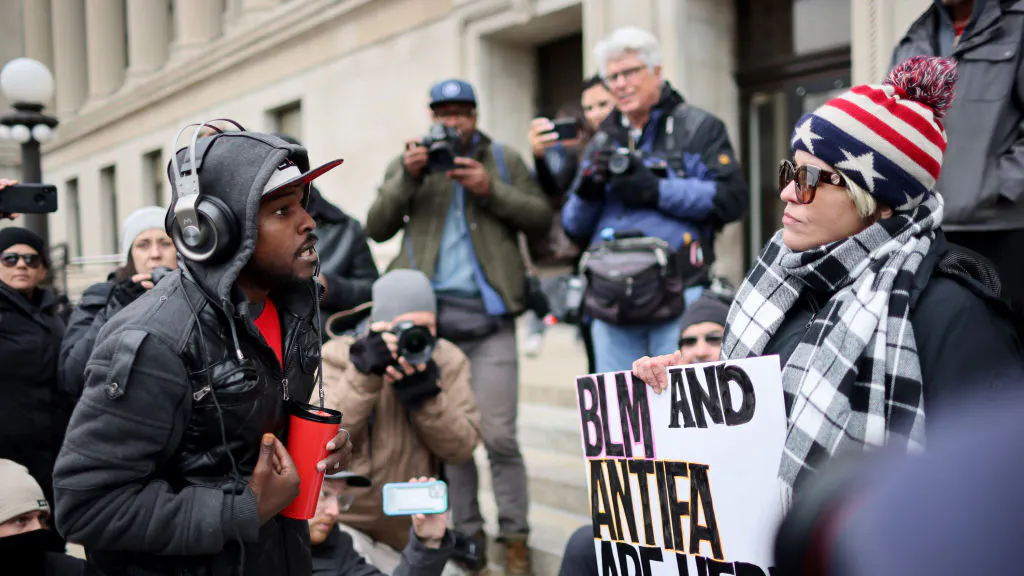KENOSHA, Wis. — After dismissing six members of the jury, the remaining 12 jurors in the Kyle Rittenhouse case have been released to deliberate. In their instructions, Judge Schroeder reminded the jury that the decision is theirs alone. He cautioned them not to factor in anyone’s opinions, even the opinions of President Joe Biden or former President Donald Trump.
“You will pay no heed to the opinions of anyone, even the President of the United States or the President before him,” Schroeder told the jury.
Meanwhile, news vans line the streets outside the Kenosha courthouse, and reporters far outnumber protestors. As of Tuesday morning, a small group of Black Lives Matter activists had gathered outside the building chanting slogans. Among them was Justin Blake, a prominent activist, and the uncle of Jacob Blake, the man shot and wounded by police while in possession of a knife and resisting arrest in August of 2020, the event which precipitated widespread rioting in Kenosha during which Rittenhouse shot three men.
We spoke to Justin Blake about his thoughts on the case. Blake characterized the case as an example of “white supremacy,” alleging that Rittenhouse’s defense is directly funded by “the clan.” While Blake was severely critical of Judge Schroeder, accusing him of “racism” — evidenced by the judge’s ringtone (“God Bless The USA”), which Blake characterized as “Trump’s theme song” — he reserved his most potent criticism for President Joe Biden, who he claims has abandoned the black voters who put him in office. “[President Biden] has failed us,” Blake proclaimed emphatically. “We’ve heard nothing from them… We will never, in my life, vote for another Democrat again. We helped flip this state blue. What did we get? What African Americans always get, nothing.” Blake insisted that now may be the time to start looking to “a third party.”
Both the prosecution and the defense gave closing arguments in the Kyle Rittenhouse case Monday. As of Tuesday morning, the jury was instructed to begin deliberations.
The Case Against Kyle
In their closing, the prosecution relied heavily on the “active shooter” narrative, claiming that the three men Rittenhouse shot were acting in self-defense. Assistant District Attorney Thomas Binger claimed that the men who pursued and were eventually shot by Rittenhouse were “heroes” for attempting to subdue Rittenhouse out of alleged concern that he was an active shooter threat.
The prosecution attempted to frame Rittenhouse as the initial aggressor, and paint the three men he shot, Joseph Rosenbaum, Gaige Grosskreutz, and Anthony Huber, as acting in self-defense. Their legal argument is that Kyle cannot claim self-defense if he initiated the dangerous situation.
Prosecutors pointed to FBI drone footage they claimed shows Rittenhouse raising his gun in a threatening manner prior to the first altercation with Rosenbaum. The prosecution did not claim Rittenhouse pointed the gun at anyone specifically, rather that his posture was sufficiently menacing that it may have reasonably led others to think that Rittenhouse was an imminent threat. The defense disputed that characterization, saying the drone footage does not show Rittenhouse raising his gun. The defense argued that the footage shows the gun was situated on the wrong side of Rittenhouse’s body for him to be aiming it forward.
The prosecution also questioned whether Rittenhouse should have resorted to deadly force, accusing him of “bringing a gun to a fist fight.” They argued that a skateboard is a children’s toy and could not be reasonably interpreted as a “weapon” capable of deadly force. Regarding Grosskruetz’s gun, the prosecution argued that it was not lifted and aimed at Rittenhouse the moment Rittenhouse discharged his weapon.
Overall, the prosecution focused on dressing down Rittenhouse’s personal character for poor choices that evening. Prosecutors emphasized that he lied about being an EMT and when he initially claimed that Rosenbaum pulled a gun on him. They argued that at 17, Rittenhouse should not have inserted himself into a dangerous situation, and that the ensuing deaths were directly caused by Rittenhouse’s actions.
The prosecution’s strategy was not without notable missteps. Binger downplayed damage from rioters, which could potentially play poorly with a jury of Kenosha residents. Binger appeared to dismiss “dumpster fires” that occurred that night and insinuated that Rosenbaum, who was involved in arson that night, was harmless, comparing him to “a little dog who barks.” He also called the men Rittenhouse shot “heroes” several times despite their extensive criminal histories, and their behavior at the riot that night, a claim which may seem a stretch to some jurors.
The Case For Kyle
After the prosecution’s closing arguments, the defense took over to deliver theirs. The defense’s strategy was less methodical, but the video evidence appeared to cut in favor of the defense in multiple instances.
The defense clearly established that Rittenhouse was being pursued during each instance in which he fired his weapon. One slow-motion video showed Rittenhouse first being pursued by Rosenbaum and then cornered between two cars, with Rosenbaum rapidly closing in on Rittenhouse to within 4 feet.
Video footage also showed Rittenhouse being pursued by a group of protestors, before he was kicked in the head by an unidentified man and hit with a skateboard by Huber.
The defense’s objective was to prove that Rittenhouse was afraid for his life in the moment he used the firearm in self-defense, and much of the footage seems to corroborate that claim.
As of publication, the jury is deliberating whether Rittenhouse committed intentional homicide, or whether he acted in self-defense. Meanwhile 500 national guard service people are stationed to defend the city if additional rioting breaks out.
This is an emerging story and will be updated as details come to light.

.png)
.png)

